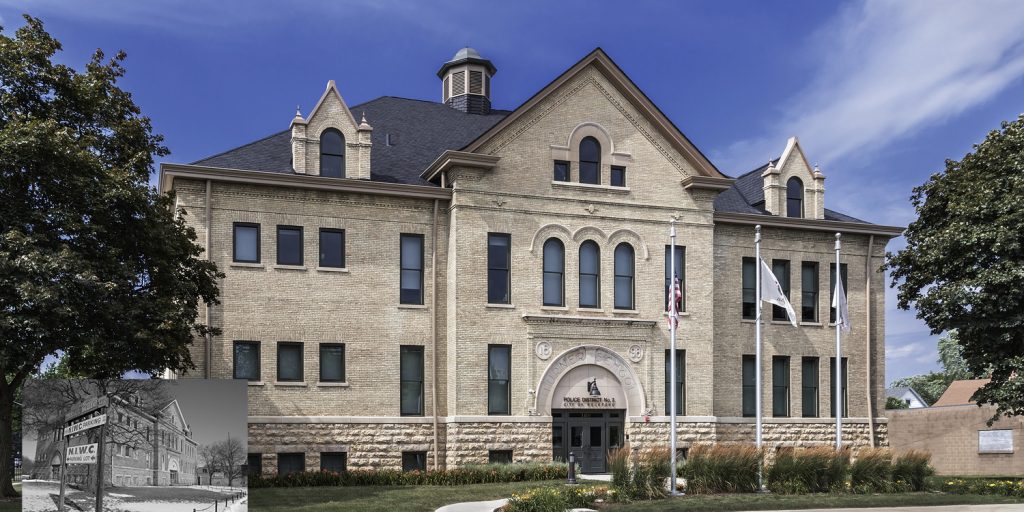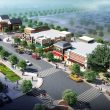Adaptive reuse and municipal facilities: Strengthening mutual trust
Every community has its share of underutilized buildings—empty warehouses, shuttered schools, abandoned grocery stores and retail strip malls, and aging postal facilities—that have reached the end of their useful lives. Many pose safety concerns, while others often become magnets for crime. With the cost of construction increasing year after year, many municipalities are taking another look at these community eyesores through an adaptive reuse lens and transforming them into state-of-the-art municipal or public safety facilities at a fraction of the cost of building new. Below are strategies, insights, and suggestions to consider when undertaking an adaptive reuse project.
What is adaptive reuse? Adaptive reuse refers to repurposing an existing structure for a new use. Adaptive reuse can turn community liabilities into assets and is a cost-effective way to propel economic development and neighborhood revitalization. Many commercial developers have used this approach to transform older structures like warehouses and office buildings into apartments and condominiums.
Savvy municipalities are taking a page from developers’ notebooks and leveraging underutilized or empty buildings to create new municipal or public safety facilities. In order to be successful, the building has to be structurally sound, and the new use for the property should be economically viable and a good location for municipal operations
Why consider an adaptive reuse approach? There are multiple reasons to consider adaptive reuse for your next public safety or municipal project. From reduced cost to enhancing community perception, revitalizing an existing building in your community is important because it helps:
Honor local history. When a beloved local grade school, for example, is saved as the City of Rockford (Illinois) did, it helps connect law enforcement agencies with the community. It supports the historic preservation of buildings that would otherwise be demolished.
Maintain vital city centers. In cities and towns, vacant buildings contribute to reduced pedestrian foot traffic, and slowly the city center begins to lose its vitality. Often developers choose land for new projects outside of the city center, which fuels “urban sprawl” that has been shown to contribute to negative environmental impacts such as increased pollution and traffic. Adaptive reuse can offer an alternative to urban sprawl.
Create community pride. Targeted adaptive reuse can help transform blighted areas in the community. For example, Village of Bensenville leaders identified an abandoned manufacturing building in a part of town that had significant gang and drug sales activity. Recognizing that investing in the area would help change the dynamic and enhance community support, the Village purchased the property and successfully transformed the building into a new community police and emergency management facility that features a community meeting space.
What are some of the benefits of an adaptive reuse approach?
Taking an adaptive reuse approach offers significant cost, schedule, and environmental benefits, including:
Quicker completion. Renovating a building often can take less time than new construction, especially if the structural components of the building are sound. Some spaces may only require minor upgrades.
Open book transparency. Adaptive reuse of existing buildings within the community presents opportunities to send a message to the public about how municipalities are using community resources in a cost-effective manner. Municipal and law enforcement budgets often receive a lot of scrutiny, and reduced construction costs can be returned to municipal coffers to pay for additional staff, training, or community programs.
Supporting sustainable development. Renovating an older structure with new energy efficient systems can reduce the carbon footprint of your project. In addition, adaptive reuse conveys a positive message to the public about how municipalities are using existing resources in a sustainable way. Preserving the historic fabric of the community is just one aspect. Adaptive reuse also reduces the amount of building materials headed to a landfill.
Key steps to consider with an adaptive reuse approach.
Adaptive reuse can be a cost and time-saving approach for law enforcement and other public safety, or municipal facilities when looking to expand. However, it is not without pitfalls or drawbacks. Below are key steps to consider before undertaking an adaptive reuse project:
Hire the right team. Adaptive reuse is not for novices. Get input from professionals, including an architect, engineer, and construction manager or contractor with experience in adaptive reuse. If the building you are considering has historic properties, consider hiring a historic conservation professional or a local town or county historian to determine if grants or other federal dollars are available and what restrictions may apply with regard to alterations.
Assess the building. Your team will assess the building and perform an environmental analysis to ensure it’s a good candidate for adaptive reuse. While a formal assessment and analysis may be expensive, moving forward with an adaptive reuse project without adequately assessing the building can lead to excessive hidden costs during construction. Your team also should research local zoning laws to ensure the new use is allowed.
Survey the neighborhood. Not only is assessing the building important, remember to take into consideration the entire neighborhood. Is it the right fit? Will the community embrace the new use? Consider pedestrian patterns, transportation options, and surrounding homes and businesses before signing off on the project.
Conduct a space needs study. Every project should begin with a space study that determines how much space and the type of space needed. Assessing the existing space available and understanding how the needs of the new use fit within the existing building is important in determining if the building under consideration is a strong candidate. If space on the property is available, an addition could be considered as needed. When planning a new facility, remember to plan for future needs, including staff increases and program expansions, so that you have room to grow.
Determine the budget. While adaptive reuse often has lower costs than building from the ground up, it can be expensive, depending on how much rehabilitation work is required. With the space study completed, have your architect and construction manager or contractor provide estimates of the project cost, including both interior and exterior upgrades required to bring the existing building up to current code requirements. If the use is public safety, assess what structural upgrades are needed to bring the building up to critical facility standards.
Identify unique elements. During the design process, identify the elements to be reused, from the structure, to roof to the walls. Try and incorporate elements that respect the building’s original use and its unique features. This is especially important if the building has historical significance. During the design process, investigate the building’s repair history to determine which areas have been recently upgraded or have posed challenges.
The integration of municipal and public safety buildings within the community is a critical element. Strong relationships of mutual trust between law enforcement agencies and the communities they serve are critical to maintaining public safety and effective policing. The successful adaptive reuse of aging or vacant buildings in our cities into community-responsive public safety facilities can help strengthen that mutual trust.
Brian Meade, AIA, LEED AP, is design principal with FGM Architects. He can be reached at [email protected]. Louise Kowalczyk, AIA, LEED AP, is design principal with FGM Architects. She can be reached at [email protected].


















